We’re rounding up our 10-part Sound Design series with a look at granular synthesis, and take a deep dive into some of the very best granular plugins for breaking your sounds into tiny grain particles and smashing them back together in interesting and never-quite-heard-before ways. Let’s go…
What Is Granular Synthesis?
Granular synthesis is a method of splitting a constant incoming sound into tiny snippets (1-50ms in length), referred to as grains, which can then be reconfigured, modulated and resequenced, and spat out the other end as a new, generally quite ethereal sound. The degree to which the new sound is recognisable to the original source is determined by several parameters:
Grains – sets the number of grain samples being played back simultaneously
Length – sets the length of each grain, usually denoted in milliseconds, allowing for more staccato/choppy effects with shorter lengths or smoothing things out with longer ones.
Position – determines where in the source sample the grains will be sampled from; as with other granular plugin controls, the Position knob often pairs with a Random control to randomize the position of every grain, for an infinitely evolving sound.
Speed – determines how fast you move through the source sample, playing grains as you go. Negative values make the grains play back in reverse.
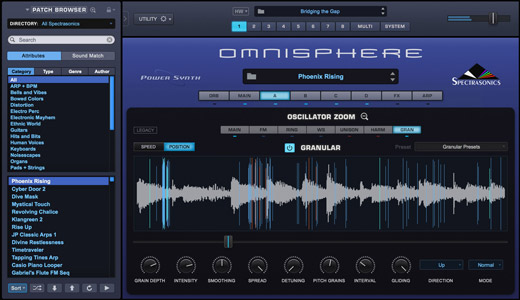
The effect of Omnisphere’s main controls in the Granular editor window are represented by the scanning blue lines moving across the waveform of the source audio sample being processed.
With the number, length and position of the grains determined, the granular engine can play them back consecutively, reversed, partially overlapping, or layered neatly on top of each other; the volume and frequency content can be adjusted; grains can be looped, enveloped, pitched up or down, panned across the stereo field, phase aligned… You get the idea.
“Essentially, granular allows you to morph, stretch, push and pull the very “molecules” of your sounds, and in real time.”
What Is Granular Synthesis Good For? – Some Tips
To my mind, granular synthesis is inherently futuristic sounding, partly I think due to the subtle glitchiness and otherworldliness imparted by the character of the clouds of grains (It was so futuristic, in fact, that when composer Iannis Xenakis came up with the concept in the late 1950s, he had no way of actually trying it out with the kinds of powerful digital processing tools that we have at our disposal today, and had to make do with analog tone generators and very laborious-sounding tape splicing!).
But also because you get a lot of movement built into a granular patch, with the grains providing very complex and subtle modulations that immediately make it sound much more sophisticated and fascinating than a typical subtractive synth starter patch.
Organic electronic to industrial electronic
You can use source samples of acoustic and organic instruments and environments, and mangle them while still retaining something of their organic, real-world essence — if desired. You can also create very robotic, morphing mechanical sounds too. In all, it’s an undoubtedly atmospheric sound, perfect for generating cinematic pads, drones and FX layers with relative ease.
Synthesis, meet sampling
Perhaps the greatest aspect of granular synthesis for sound designers is that is truly blurs the line between synthesis and sampling. The best granular processing tools allow you to import (ideally drag and drop) your own audio samples as source material, so you can start coming up with absolutely unique textures and effects right away, and you will never run out of creative possibilities. The creative possibilities will be dictated simply by your ingenuity with combining source audio material with great granular processing settings – and unlike with more traditional subtractive synths, there really are limitless possibilities.
Reinvent your sample collection
Granular synthesis gives your existing sample library a whole new lease of life! Thought you had done everything your could with your current drum samples? Why not use them as the basis for a bespoke collection of new ambient pad sounds? Or use kick drum one-shots as the basis for rippling percussion loops?
As with most of the techniques and tools covered in our sound design series, some combinations of source material and particular processing tools work better than others for creating useable and desirable results. Granular is no different, and which granular plugins you connect with most will be determined by a number of things: first of course, the quality and character of the sound produced; but also consider which interface you find easiest and most inspiring to explore and get experimental with, and which plugins have the controls, flexibility and additional features that you reach for most.
Blend granular processing with the dry sound
Granular doesn’t have to an all or nothing affair. Like any effects processing, you can achieve some of the best and most polished results by applying granular more delicately to simply enhance certain aspects or frequencies of an existing sound, adding subtle reinforcement or additional movement and interest around the edges of the part without completely transforming its character. Seeing granular processing as just another shade in your palette, rather than a big splash of solid colour that has to drench everything, will lead you to more sophisticated sounds and uses in your compositions.
Combine granular processing with other effects
Of course, you can combine granular processing with other effects. Reverb and delay are especially good effects for granular sounds, mainly because they can be used to extend and accentuate the dreamy, ethereal droning quality that granular excels at.
But don’t stop there: try feeding your previously distorted, compressed, pitch-shifted, reversed and otherwise heavily processed sounds into one of the granular plugins below, and see what new twists you can bring. Try the granular processing both before and after your other processing and editing: you’ll get quite different results.
We’ve discussed some of the best sound design processing techniques in the previous articles in this series, like stereo processing, layering and distortion, so if you want to dig more into these areas, be sure to catch up on the previous parts in the series:
- Part 1 – Delay
- Part 2 – Distortion
- Part 3 – Layering
- Part 4 – Classic Modulation FX
- Part 5 – Stereo & Panning FX
- Part 6 – Pitch Shifting
- Part 7 – Reverb
- Part 8 – Step Sequencers & Envelope Generators
- Part 9 – Creative Filtering
- Part 10 – Granular Synthesis & Sample Processing
The Best Granular Plugins For Sound Design: Roundup List
Granular synthesis plugin processors fall into two broad categories. First, those that need to be fed with a pre-recorded audio sample to act as a kind of “oscillator” sound source. These might be typically be considered granular “instruments” in their own right. And second, there are plugins that are designed to be used as insert effects for processing source sounds in real time, behaving in much the same way as other effects processors like phasers and reverbs.
Here we’ve put together a list that includes a bunch of our favourites of both types. Check it out:
1. Audio Damage Quanta
Hitting a sweet spot between recognisable and highly playable synthesizer parameters and interface features that invite granular exploration, Quanta makes quality granular textures easy and exciting and has to be up there with the very best granular plugins currently available.
Available for: Mac, PC | VST2, VST3, AU, AAX
BUY NOW via Plugin Boutique.2. Inertia Sound Systems Granulizer 2
Something of a next-gen granular plugin for me, with the clean streamlined GUI of The Mangle’s and Granite’s (more on those further down) but with some different sculpting features that are at once intriguing and a huge amount of fun to explore.
Available for: Mac, PC | VST2, VST3, AU
BUY NOW via Inertia Sound Systems.3. Steinberg Padshop 2
With version 2, Steinberg overhauled Padshop into a much more modern granular affair, with a bunch of new filters and effects, an added arpeggiator and a whole new second spectral synthesis engine.
If you’re a Cubase Pro user, you’ll be lucky enough to find Padshop included in the bundled plugin instrument library. But even if you don’t use Cubase, you should still consider Padshop if you’re after some of the highest-quality, smoothest granular pads and effects around.
Also see: Steinberg’s HALion 6 mega-sampler features a cutting-edge granular engine, and incorporates the Skylab granular instrument which is similar to Padshop.
This video offers a good, concise overview of some of the effects you can achieve with Padshop:
Available for: Mac, PC | VST2, VST3, AU, AAX
BUY NOW via Steinberg.4. NI Reaktor Ensembles (Free and Premium)
By now the worst-kept secret in music software must be how fun and exciting it can be delving into the online library of free user-created ensembles made for Reaktor 6. And of course there are a range of granular ensembles to check out: Dron-e, GrainStates, GrainCube, GRIP Grain Cloud Synth… the list is too long to really even skim the surface here.
Beyond the free user ensembles, there are also some premium third-party offerings that are more than worth mentioning: Twisted Tools have a whole range of multi-effects processors that incorporate granular modules like Buffeater and Rolodecks, as well as the free granular sampler FLAKES; there is also Blinksonic Cataliz, a very cool granular synth and beatlooper.
Also see: Native Instruments have a couple of premium Reaktor Player-hosted granular synths, Form and Straylight, which provide a clearer (but far less fun and satisfying) path to achieving your own granular sounds.
Available for: Mac, PC | VST2, VST3, AU, AAX
DOWNLOAD via Native Instruments Reaktor User Library.5. Ableton Max For Live Devices (Free and Premium)
For Ableton Suite users, the Max For Live (M4L) devices user and third-party libraries offer a similar playground, and also feature some great granular processors that will particularly appeal to those you prefer to stay within the Ableton devices ecosystem when producing and experimenting.
Of course there is Robert Henke’s (aka electronic/glitch pioneer Monolake) well-known Granulator II which is even now included in Live 10 Suite; Grain Scanner from Amazing Noises, and the granular synth/looper Iota.
Available for: Mac, PC | VST2, AU
BUY NOW via Ableton.6. Melda Productions MGranularMB
Czech developers Melda Productions are quietly building an impressive reputation through their vast range of modest-seeming-but-actually-very-powerful-and-versatile audio plugins that cover every possible processor you might need for mixing, mastering or sound design processing duties. The “MB” in MGranularMB stands, as usual, for multi-band, allowing you to process your sound source in several different frequency bands, providing a degree of control over the granular effect that is unusually precise and frequency-specific. This makes it especially good for adding granular effects to bolster existing instruments and elements in your mix like drums and lead sounds rather than completely transforming things beyond recognition, although it is entirely capable of that too when you want.
Available for: Mac, PC | VST2, VST3, AU, AAX
BUY NOW via Plugin Boutique.7. Sound Guru The Mangle
The Mangle was one of the first modern-era plugins to nail a certain flavour of “musical” granular sound that has made it an early and enduring favourite of many professional sound designers and media composers.
A straightforward interface with intuitive controls and a pleasing but not obtrusive eye-candy animation of active grains make this a solid workhorse granular processor for quick experiments and batch processing.
Available for: Mac, PC | VST2, AU, AAX
BUY NOW via Sound Guru.8. New Sonic Arts Granite
Like The Mangle, another workhorse granular sample mangler that strikes a great balance between streamlined efficiency and offering a well-considered number of modulation capabilities to quickly transform and sculpt your sounds. As well as excellent, musical results. Maximum fun for sure.
Available for: Mac, PC | VST2, AU, Standalone
BUY NOW via New Sonic Arts.9. Hvoya Audio Ribs
One of several good free granular effects plugins, Ribs is an excellent choice for dipping your toe into the world of granular synthesis and seeing if it’s your timbral jam before spending money on fancier premium options – it may be all the granular you need.
Also see: Argotlunar, another good free option for both Mac and PC.
Available for: Mac, PC | VST2, AU
DOWNLOAD via Plugin Boutique.10. Audiority GrainSpace
GrainSpace has a more knobby, hardware-inspired interface that could certainly inspire where other more futuristic-looking plugins can get distracting. Supremely flexible and nicely laid out, providing a plethora of controls that really invite tweaking, experimenting and listening. My favourites of course: the Freeze control and the Chord Resonator, ideal for techno.
Note: Some have noted the resemblance to Mutable Instruments Clouds module. If you are especially keen to acquire the sound of the Clouds hardware Eurorack module in plugin form, you could also consider Softubes official software emulation that is available as an add-on for their Modular plugin suite.
Available for: Mac, PC | VST2, VST3, AU, AAX
BUY NOW via Plugin Boutique.11. Inear Display Litote
Litote is subtitled as a “granular exploration box”, which sums it up pretty well. A deceptively simple GUI houses some very cool features for producing morphing, infinitely-evolving and randomized granular soundscapes.
Central to Litote’s operation are the XY pad, allowing you to morph between up to four different audio engines, and the Trajectory section where you can set the plugin on a semi-random path, sit back and watch/hear it unfold – a bit similar to Omnisphere’s The Orb modulation device thingy.
Available for: Mac, PC | VST2, AU
BUY NOW via Inear Display.13. Glitchmachines Palindrome
Glitchmachines, headed by sound designer Ivo Ivanov, have created several glitch effects and instrument plugins over the years, and Palindrome is the jewel in the crown to date: 4 granular samplers fused together which can all be modulated and effected separately, before being brought together for multi-layered granular chaos. Palindrome, like other Gltichmachines plugins, features a large number of points in the signal paths for randomisation, which help make it especially good for generating loads of sonic variations very quickly: always high on any serious sound designers priority list.
Also see: GlitchMachines Polygon is another VST instrument with granular capabilities, while Fracture XT is an excellent granular glitch processor insert effect, again with multiple randomisers.
Available for: Mac, PC | VST2, AU, AAX
BUY NOW via Plugin Boutique.14. Xenakios PaulXStretch
An odd entry perhaps in a discussion of granular plugins, since PaulXStretch is not technically a granular processor. However, it does produce results reminiscent of beautifuly gritty granular pads and drones, and I’m betting that if you’re remotely interested in granular sound design, you’ll certainly also be excited by what you can achieve with this one.
Based on an original standalone app called PaulStretch, PaulXStretch is an effort by indy developer Xenakios to put the same functionality into a more convenient VST/AU plugin that you can load in your DAW.
Basically, PaulXStretch uses an extreme time-stretching algorithm (think 8x or more) to stretch out any sound sample waaay beyond recognition and turn it into a long, smooth-but-grainy, almost universally beautiful drone. There are only really a couple of controls: duration and resolution. Experiment with different combinations of these two factors on a variety of material for subtly different timbral effects, but either way, grainy ambient magic is almost guaranteed whatever audio you throw into it.
Available for: Mac (though not tested with Catalina), PC | VST2, AU
DOWNLOAD via Xenakio’s Blog.15. accSone Crusher-X 8.5
Perhaps the most full-featured and slick granular synth processor, Crusher-X is designed for post production and sound design industry-grade granular processing. Not cheap, but arguably the very best dedicated solution in the granular business.
Check out this short demo of sounds being processed with Crusher-X by Hollywood movie trailer sound design specialist Robert Dudzic:
Available for: Mac, PC | VST2, AU
BUY NOW via accSone.16. Madrona Labs Kaivo
Kaivo is a semi-modular software synthesizer with a similar semi-modular patching layout to Madrona’s other flagship synth Aalto. Kaivo’s USP, though, is that it features a rather unusual but exceedingly powerful combination of sound generators: granular synthesis and physical modelling.
Using the Granulator, Resonator and Body modules, you can come up with some very cool and expressive patches that have a character quite distinct from your typical straight-up granular synths. Recommended.
Available for: Mac, PC | VST2, AU
BUY NOW via Madrona Labs.17. Omnisphere 2.6
Somewhat buried amongst the vast range of sonic options that make up Omnisphere, you’ll find a granular processing function, which combined with the ability to import your own samples introduced in version 2, makes this powerhouse synth a perhaps unexpected granular processing beast. Load your own sounds or draw from the famously extensive factory library, swtich on the Granular module in the selected Oscillator settings window, and you’re away. Try combining the granular processing with FM or Ring Modulation, and stack granulated sample layers and synthesizer oscillators, in any combination, in the 4 available oscillator slots, for even more sonic mangling possibilities.
The controls and GUI of the Granular section are fairly streamlined, but when combined with the many other features and effects of Omnisphere, you’re not really inhibited from getting pretty detailed with your processing. In fact, Spectrasonics have a knack of providing just the right number of controls for balancing speed and depth of work.
Available for: Mac, PC | VST2, AU, AAX, Standalone
BUY NOW via Spectrasonics.18. Output Portal
Portal is an extremely musical take on granular, and excels for processing vocals, synths and lead lines. The initilaized GUI is pretty streamlined, centering on the circular visualizer that illustrates the granular parameters, but you can also go under the hood on the Advanced page if desired and get hands-on control of every aspect of the processing. Beautifully done.
Available for: Mac, PC | VST2, VST3, AU, AAX
BUY NOW via Plugin Boutique.19. SoundMorph Dust
Another granular processor with a mesmerizing visualizer panel, Dust is based on the physics of a real-time particle simulation, so you can set the number and motion of the particle “emitters” bouncing around the main window and hear how the granular parameter values change accordingly. It’s so fun, and sounds equally fantastic, although you might forget what you were doing before once you start watching the animated emitters…
Available for: Mac, PC | VST2, VST3, AU, AAX
BUY NOW via SoundMorph.That wraps up this series on sound design – it turned out to be a lot more work than I anticipated(!) at the start, but I’m super pleased to have put together such a broad-ranging resource for you, and I hope you find a bunch of useful and inspiring tips and discover new plugins that will aid you in your own quest for original and evocative sounds in your productions. Thanks for reading!
For a bunch more sound design tips and other related plugin recommendations, don’t forget to catch up on the previous parts in the series:
- Part 1 – Delay
- Part 2 – Distortion
- Part 3 – Layering
- Part 4 – Classic Modulation FX
- Part 5 – Stereo & Panning FX
- Part 6 – Pitch Shifting
- Part 7 – Reverb
- Part 8 – Step Sequencers & Envelope Generators
- Part 9 – Creative Filtering
- Part 10 – Granular Synthesis & Sample Processing
For a lot more sound design and processing tips, check out the Ultimate Guides series, a definitive collection of tips and techniques for enhancing your music and bringing it to a professional level:
If you liked this post, you’ll definitely find these useful too:
What’s The Best DAW Music Production Software, Really? An Essential Buyers Guide





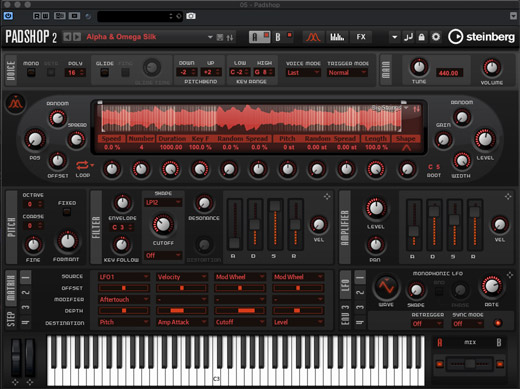








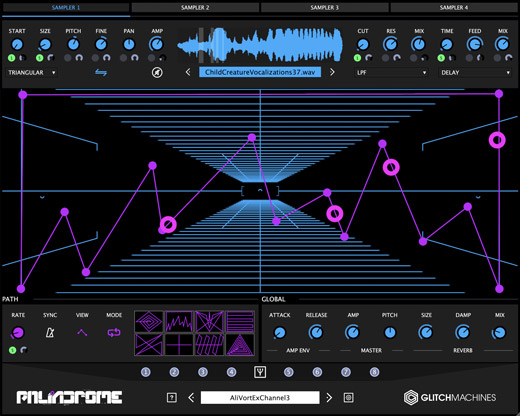





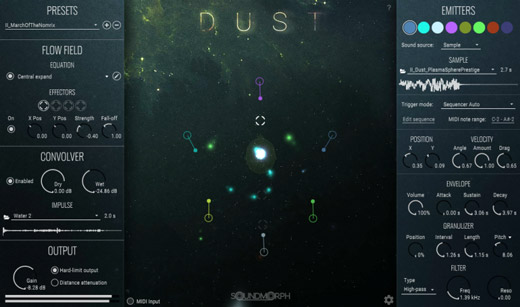

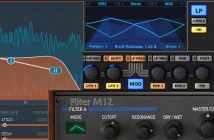


2 Comments
Thank you so much for this series! It’s genuinely been really inspiring to follow and has absolutely introduced me to a lot of tools that have really given new life to my sound design and workflow.
I know you said this series was more work than you had initially anticipated, but I’d be curious if you’d ever be willing to revisit the series in the future covering spectral processing, designated multi-effects, and/or miscellaneous sound design. Mostly because I particularly love how you break down the best applications and advantages to each plugin, how you cover various techniques for using each type of effect, and how deliberate and varied your selection of plugins is.
Regardless, I wanted to express my gratitude for the series! You consistently have introduced me to great new tools or have made me rethink tools I had previously dismissed. (I had no idea how much I needed Geist 2 in my life until it came up in your lists twice). Your effort clearly shows and is hugely appreciated!
Thanks for your kind words Heike, that’s awesome to hear that you’ve got a lot out of this series!
Funny that you mentioned multi-effects, I was thinking I would do a write-up on exactly this following these Sound Design articles – so stay tuned for this coming soon. Cheers!